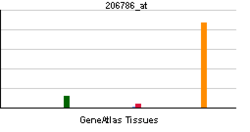HTN3
Histatin 3, also known as HTN3, is a protein which in humans is encoded by the HTN3 gene.[2][3]
Function
The primary protein encoded by HTN3 is histatin 3. Histatins are a family of small, histidine-rich, salivary proteins, encoded by at least two loci (HTN3 and HTN1). Post-translational proteolytic processing results in many histatins: e.g., histatins 4-6 are derived from histatin 3 by proteolysis. Histatins 1 and 3 are primary products of HIS1(1) and HIS2(1) alleles, respectively. Histatins are believed to have important non-immunological, anti-microbial function in the oral cavity.[2] Histatin 1 and histatin 2 are major wound-closing factors in human saliva.[4]
| allele |
gene |
protein |
| HIS1 |
HTN1 |
histatin 1 |
| HIS2 |
HTN3 |
histatin 3 → histatins 4-6 |
References
Further reading
- Troxler RF, Offner GD, Xu T, et al. (1990). "Structural relationship between human salivary histatins.". J. Dent. Res. 69 (1): 2–6. doi:10.1177/00220345900690010101. PMID 2303595.
- vanderSpek JC, Offner GD, Troxler RF, Oppenheim FG (1990). "Molecular cloning of human submandibular histatins.". Arch. Oral Biol. 35 (2): 137–43. doi:10.1016/0003-9969(90)90175-A. PMID 2344289.
- Sugiyama K, Ogino T, Ogata K (1990). "Rapid purification and characterization of histatins (histidine-rich polypeptides) from human whole saliva.". Arch. Oral Biol. 35 (6): 415–9. doi:10.1016/0003-9969(90)90202-L. PMID 2372245.
- Sabatini LM, Azen EA (1989). "Histatins, a family of salivary histidine-rich proteins, are encoded by at least two loci (HIS1 and HIS2).". Biochem. Biophys. Res. Commun. 160 (2): 495–502. doi:10.1016/0006-291X(89)92460-1. PMID 2719677.
- vanderSpek JC, Wyandt HE, Skare JC, et al. (1989). "Localization of the genes for histatins to human chromosome 4q13 and tissue distribution of the mRNAs.". Am. J. Hum. Genet. 45 (3): 381–7. PMC 1683406
 . PMID 2773933.
. PMID 2773933.
- Oppenheim FG, Xu T, McMillian FM, et al. (1988). "Histatins, a novel family of histidine-rich proteins in human parotid secretion. Isolation, characterization, primary structure, and fungistatic effects on Candida albicans.". J. Biol. Chem. 263 (16): 7472–7. PMID 3286634.
- Dickinson DP, Ridall AL, Levine MJ (1988). "Human submandibular gland statherin and basic histidine-rich peptide are encoded by highly abundant mRNA's derived from a common ancestral sequence.". Biochem. Biophys. Res. Commun. 149 (2): 784–90. doi:10.1016/0006-291X(87)90436-0. PMID 3426601.
- Sabatini LM, Azen EA (1994). "Two coding change mutations in the HIS2(2) allele characterize the salivary histatin 3-2 protein variant.". Hum. Mutat. 4 (1): 12–9. doi:10.1002/humu.1380040103. PMID 7951254.
- Sabatini LM, Ota T, Azen EA (1993). "Nucleotide sequence analysis of the human salivary protein genes HIS1 and HIS2, and evolution of the STATH/HIS gene family.". Mol. Biol. Evol. 10 (3): 497–511. PMID 8336540.
- Tsai H, Raj PA, Bobek LA (1997). "Candidacidal activity of recombinant human salivary histatin-5 and variants.". Infect. Immun. 64 (12): 5000–7. PMC 174480
 . PMID 8945538.
. PMID 8945538.
- Iontcheva I, Oppenheim FG, Offner GD, Troxler RF (2000). "Molecular mapping of statherin- and histatin-binding domains in human salivary mucin MG1 (MUC5B) by the yeast two-hybrid system.". J. Dent. Res. 79 (2): 732–9. doi:10.1177/00220345000790020601. PMID 10728974.
- Naurato N, Wong P, Lu Y, et al. (2000). "Interaction of tannin with human salivary histatins.". J. Agric. Food Chem. 47 (6): 2229–34. doi:10.1021/jf981044i. PMID 10794615.
- Gusman H, Travis J, Helmerhorst EJ, et al. (2001). "Salivary histatin 5 is an inhibitor of both host and bacterial enzymes implicated in periodontal disease.". Infect. Immun. 69 (3): 1402–8. doi:10.1128/IAI.69.3.1402-1408.2001. PMC 98034
 . PMID 11179305.
. PMID 11179305.
- Grogan J, McKnight CJ, Troxler RF, Oppenheim FG (2001). "Zinc and copper bind to unique sites of histatin 5.". FEBS Lett. 491 (1–2): 76–80. doi:10.1016/S0014-5793(01)02157-3. PMID 11226423.
- Gyurko C, Lendenmann U, Helmerhorst EJ, et al. (2002). "Killing of Candida albicans by histatin 5: cellular uptake and energy requirement". Antonie Van Leeuwenhoek. 79 (3–4): 297–309. doi:10.1023/A:1012070600340. PMID 11816973.
- Baev D, Li XS, Dong J, et al. (2002). "Human salivary histatin 5 causes disordered volume regulation and cell cycle arrest in Candida albicans". Infect. Immun. 70 (9): 4777–84. doi:10.1128/IAI.70.9.4777-4784.2002. PMC 128240
 . PMID 12183519.
. PMID 12183519.
- Strausberg RL, Feingold EA, Grouse LH, et al. (2003). "Generation and initial analysis of more than 15,000 full-length human and mouse cDNA sequences". Proc. Natl. Acad. Sci. U.S.A. 99 (26): 16899–903. doi:10.1073/pnas.242603899. PMC 139241
 . PMID 12477932.
. PMID 12477932.
- Li XS, Reddy MS, Baev D, Edgerton M (2003). "Candida albicans Ssa1/2p is the cell envelope binding protein for human salivary histatin 5". J. Biol. Chem. 278 (31): 28553–61. doi:10.1074/jbc.M300680200. PMID 12761219.
- Ahmad M, Piludu M, Oppenheim FG, et al. (2004). "Immunocytochemical localization of histatins in human salivary glands". J. Histochem. Cytochem. 52 (3): 361–70. doi:10.1177/002215540405200307. PMID 14966203.
- Castagnola M, Inzitari R, Rossetti DV, et al. (2004). "A cascade of 24 histatins (histatin 3 fragments) in human saliva. Suggestions for a pre-secretory sequential cleavage pathway". J. Biol. Chem. 279 (40): 41436–43. doi:10.1074/jbc.M404322200. PMID 15272024.

 . PMID 2773933.
. PMID 2773933. . PMID 8945538.
. PMID 8945538. . PMID 11179305.
. PMID 11179305. . PMID 12183519.
. PMID 12183519. . PMID 12477932.
. PMID 12477932.